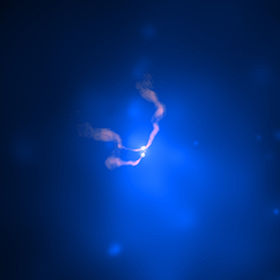
Abell 400
Encyclopedia

Galaxy cluster
A galaxy cluster is a compact cluster of galaxies. Basic difference between a galaxy group and a galaxy cluster is that there are many more galaxies in a cluster than in a group. Also, galaxies in a cluster are more compact and have higher velocity dispersion. One of the key features of cluster is...
, containing a galaxy
Galaxy
A galaxy is a massive, gravitationally bound system that consists of stars and stellar remnants, an interstellar medium of gas and dust, and an important but poorly understood component tentatively dubbed dark matter. The word galaxy is derived from the Greek galaxias , literally "milky", a...
(NGC 1128) with two supermassive black holes 3C 75 spiralling towards merger.
These two supermassive black holes are contained in NGC 1128
NGC 1128
NGC 1128 is a "dumbbell galaxy" in the Abell 400 galaxy cluster. It is the center of the 3C75 radio source and contains two orbiting supermassive black holes that may be merging. Computer simulations indicate that these two black holes will gradually spiral in toward each other until they merge....
. The galaxy, microwave radio jets, multi-million degree X-ray producing gas and resultant radio source is known as 3C 75. X-ray source 2A 0252+060 (1H 0253+058, XRS 02522+060) may be some additional or other portion of Abell 400.
The black holes are an estimated 25,000 light years apart, and thus will take millions of years to collide. Should the two supermassive black holes merge, they will form a single super-supermassive black hole.
External links
- Pair of black holes locked in death dance (CNN) Thursday, April 6, 2006; Posted: 2:46 p.m. EDT (18:46 GMT)
- Black Holes Bound to Merge (SPACE.com) 06 April 2006 11:48 am ET
- Black Holes Dance With Incredible Violence (SpaceDaily) Apr 12, 2006
- Study Finds Two Supermassive Black Holes Spiraling Toward Collision (Newswise) Apr 6, 2006

